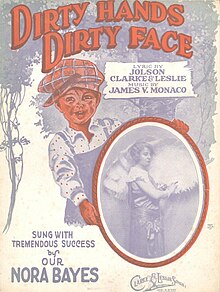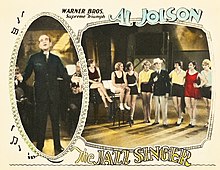Dirty Hands, Dirty Face
| "Dirty Hands! Dirty Face!" | ||||
|---|---|---|---|---|
 Sheet music cover featuring Nora Bayes, 1921 | ||||
| Single by Al Jolson with Abe Lyman's California Orchestra | ||||
| A-side | "My Mammy" | |||
| Released | 1928 | |||
| Recorded | 31 March 1928 | |||
| Genre | Pop | |||
| Label | Brunswick 3912[1] | |||
| Songwriter(s) | Al Jolson, Grant Clarke, Edgar Leslie, James V. Monaco | |||
| Al Jolson with Abe Lyman's California Orchestra singles chronology | ||||
| ||||
"Dirty Hands, Dirty Face" (or "Dirty Hands! Dirty Face!") is a song from the 1921 musical Bombo. The lyrics were written by Grant Clarke and Edgar Leslie; with music by James V. Monaco.[2] Al Jolson is often credited as a lyricist; it was common for popular performers to take a cut of the popularity of a song by being listed as a lyricist.[3] The song is about the love that a father has for his son.[4]
Jolson version
[edit]
Jolson performs the song in the 1927 film The Jazz Singer in character as Jack Robin (formerly Jakie Rabinowitz). The film concerns the attempt of Jolson's character to become a vaudeville performer against opposition from his religious Jewish family.[5] It was the film's second musical number, and occurs 18 minutes into the film in a scene at Coffee Dan's nightclub in San Francisco.[4][6] Jolson subsequently recorded the song in March 1928.[3] Gerald R. Butters in his 2002 book Black Manhood on the Silent Screen wrote that "the symbolic link with blackface (dirtiness) is obvious"; the film later featured Jolson wearing blackface.[4] After he sings the song Jolson responds to the audience's applause by saying in improvised dialogue, "Wait a minute. Wait a minute. You ain't heard nothing yet" a phrase he often said in his vaudeville performances.[7] Jolson's words were the first words spoken on camera in a feature film.[5] Michael Rogin describes them as "These first words of feature movie speech, a kind of per-formative, announce-you ain't heard nothing yet-the birth of sound movies and the death of silent film".[5] Rogin wrote in the journal Critical Inquiry in 1992 that "The "desire" that carries forward this "interiorized, moralized" oedipal narrative...is Jack's "innocent and dirty" desire-sung as "Dirty Hands, Dirty Face" to become a histrionic, vaudeville performer".[5] The "innocent and dirty" quote was derived from the writings of Pascal Bonitzer.[5]
Jolson's performance of the song was extensively analysed in the 2005 book Style and Meaning: Studies in the Detailed Analysis of Film, with "Dirty Hands, Dirty Face" being perceived as "an extraordinary revelation of the entire narrative structure of the film".[8]
Other recordings
[edit]It was recorded in August 1923 by Isabella Patricola with the Ben Selvin Orchestra.[9] Selvin also recorded a version with Irving Kaufman.[10] Judy Garland recorded it with an arrangement by Nelson Riddle for her 1957 album Judy. Garland's version was described as "corny...inspired by, yet also transcending, Jolson's style".[11][12] She also performed it for an April 1956 episode of General Electric Theater on CBS and the 23rd episode of her CBS television show, taped in February 1964.[12]
References
[edit]- ^ Larry F. Kiner; Philip R. Evans (1992). Al Jolson: A Bio-discography. Scarecrow Press. p. 102. ISBN 978-0-8108-2633-5.
- ^ David Ewen (1987). American Songwriters: An H.W. Wilson Biographical Dictionary. H.W. Wilson. p. 287. ISBN 978-0-8242-0744-1.
- ^ a b David A. Jasen (June 2004). Tin Pan Alley: An Encyclopedia of the Golden Age of American Song. Routledge. ISBN 978-1-135-94901-3.
- ^ a b c Gerald R. Butters (2002). Black Manhood on the Silent Screen. University Press of Kansas. p. 187. ISBN 978-0-7006-1197-3.
- ^ a b c d e Rogin, Michael (1992). "Blackface, White Noise: The Jewish Jazz Singer Finds His Voice". Critical Inquiry. 18 (3): 417–453. doi:10.1086/448640. ISSN 0093-1896. JSTOR 1343811. S2CID 162165251 – via JSTOR.
- ^ Edwin M. Bradley (11 August 2004). The First Hollywood Musicals: A Critical Filmography of 171 Features, 1927 through 1932. McFarland. p. 9. ISBN 978-0-7864-2029-2.
- ^ Kenneth Schuyler Lynn (1997). Charlie Chaplin and His Times. Simon and Schuster. p. 319. ISBN 978-0-684-80851-2.
- ^ University of Reading (6 August 2005). Style and Meaning: Studies in the Detailed Analysis of Film. Manchester University Press. ISBN 978-0-7190-6525-5.
- ^ Moanin' Low: A Discography of Female Popular Vocal Recordings, 1920-1933. Greenwood Publishing Group. 1996. p. 416. ISBN 978-0-313-29241-5.
- ^ Colin Larkin (27 May 2011). The Encyclopedia of Popular Music. Omnibus Press. p. 1930. ISBN 978-0-85712-595-8.
- ^ ARSC Journal. Association for Recorded Sound Collections. 1992. p. 79.
- ^ a b Scott Schechter (2006). Judy Garland: The Day-by-Day Chronicle of a Legend. Rowman & Littlefield. pp. 203–204. ISBN 978-1-58979-300-2.
